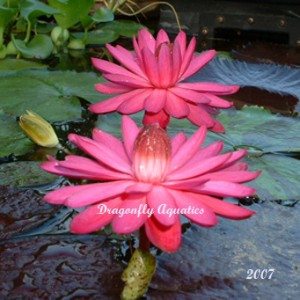We all enjoy the tropical waterlilies with their brilliant colors and large blooms but when the season ends and the water temps start to drop we wonder what we can do with them to winter them over. Here's a couple suggestions that may be successful in wintering over your tropical lilies.
TROPICAL WATER LILIES
Tropical lilies are usually treated as an annual. They will continue to grow and produce blooms until the temperatures fall below 60 degrees. If you choose to try over-wintering your tropical water lily, moving the potted plant into a greenhouse is the most successful. Another method is to re-pot the lily in a 6” pot and place the lily in at least a 20 gallon or larger aquarium. Keep the water temperature at 70-75 degrees. You will need a fluorescent grow light to provide 10 to 12 hours of artificial sunlight per day. Do not fertilize the lily at this time, as you will not want to encourage any new growth, simply keep the plant alive until temperatures are warm enough in the Spring to move the lily back outside to the pond. There is one other option for you to try if you are determined to save your tropical lily for next season. Starving the plant in late summer (do not fertilize) will cause the lily to form tubers in the fall. Once the leaves have died off, remove the tuber that has formed under the crown. Wash it thoroughly and air-dry a few days. Remove any roots still attached, wash thoroughly again and place in a jar filled with distilled water or slightly moist sand. Store the container in a cool, dark place at approximately 50 to 60 degrees. Check regularly to make sure the sand is moist, or if storing in water, that the water has not turned foul or discolored. If it has, replace it with fresh distilled water.
 This is one of our favorites! The 'Green Smoke' tropical water lily is an outstanding color of chartreuse with smoky blue tips. Its leaves are lightly speckled, bronze-green and the blooms of the 'Green Smoke' are 6-8 inches held high above the water that are platter shaped.It will spread 5-6 feet on the water surface. This is a good choice for small to medium size ponds.
This is one of our favorites! The 'Green Smoke' tropical water lily is an outstanding color of chartreuse with smoky blue tips. Its leaves are lightly speckled, bronze-green and the blooms of the 'Green Smoke' are 6-8 inches held high above the water that are platter shaped.It will spread 5-6 feet on the water surface. This is a good choice for small to medium size ponds.
You can safely place a tropical waterlily in your outdoor pond when the water reaches a consistent temperature of about 70 degrees. You can stunt the growth or even kill a tropical lily if placed into a cold pond. It sends the lily into shock, returning them to dormancy. You should fertilize the lily every two or three weeks to keep it blooming throughout the warm season.
Purchase Green Smoke, tropical water lily here.
I spent the day taking pictures of planting a tropical lily from our greenhouse to demonstrate how easily this can be done. Start with a nice size pot. I used a 16"x7" small lotus/lily container. The first picture is an example of one of our lilies that you would receive on your order. It's considered a bare root tropical lily.
Planting a tropical lily is different than planting a hardy lily. You want to make sure you get a large container so that the lily can perform at its best. It is recommended that a 2 - 7 gallon pot be used. When you first receive them remove from the plastic bag they arrive in and keep the plant wet and out of the sunlight. Put in a tray of pond water in the shade to re-hydrate it until you can plant it. The soil can be out of your flower or vegetable garden. Heavy soil with some clay base is good. You should stay away from commercial potting soils as they are too light and will float to the top of your pond. Clay kitty litter mixed with some sand will also work, if clay is not available in your area of the country. Inexpensive clay kitty litter ("calcified clay", non-deodorized, making sure it hasn't been chemically treated or deodorized.)
Topical Water Lilies are shipped "bare root" with 3 to 8 leaves and sometimes buds and flowers on them, although these may die back during the transplanting, the lily will immediately start sending up new leaves and buds. Tropical Water lilies should be planted in 2 to 7 gallon pots. A larger container will produce larger and more profuse flowering. Fill the container about half-way with a heavy clay based soil. Scoop out a section in the center of the pot. Place the tuber and roots upright in the center of the pot. Fill and firm the soil around the roots leaving the crown (where the stems and roots connect) level with the soil line keeping the crown exposed. You can then add one fertilizer tablet per gallon of soil, keeping it away from the roots. I like to top it with about an inch of pea gravel or larger size gravel to hold the soil in place, remembering to keep away from the crown of the plant. Next you can gently rinse the newly potted plant to lessen the mud escaping as you lower the pot into your pond. You should lower it to a depth of approximately 6" to 8" over the crown of the lily. Once the lily gets established you can then lower it to a depth of 12" to 18" over the crown. Tropical water lilies cannot tolerate temperatures below 65 degrees and should not be planted until the water temperatures reach and are stabilized at 70 degrees. The Night Blooming Tropical Lilies should not be set out until water temperatures have stabilized closer to 75 degrees. Planting too early can result in dormancy or cause your lily to die. Lilies are heavy feeders and should be fertilized about every 4 weeks with one fertilizer tablet per gallon of soil throughout the growing season.
It won't take long for your Tropical Water Lily to start growing and producing flowers. You can relax once again and enjoy the brillant colors of the Tropical Water Lilies.
 This Red Flare tropical night blooming lily was taken in my sister's pond. One of the best all around night blooming lilies. A deep red off set with reddish foliage. Its blooms range between 6-10 inches and the leaves spread about 6'. Good for medium to large water gardens. It produces a lot of blooms throughout the summer.
This Red Flare tropical night blooming lily was taken in my sister's pond. One of the best all around night blooming lilies. A deep red off set with reddish foliage. Its blooms range between 6-10 inches and the leaves spread about 6'. Good for medium to large water gardens. It produces a lot of blooms throughout the summer.
You can purchase Red Flare here.